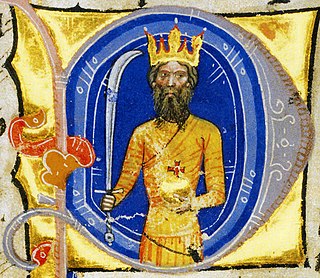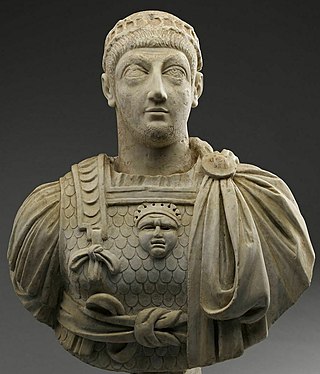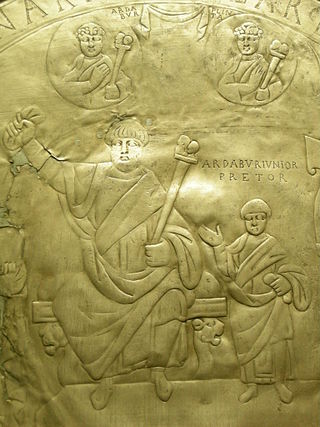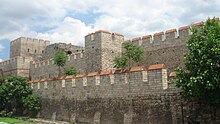
Attila, frequently called Attila the Hun, was the ruler of the Huns from 434 until his death, in March 453. He was also the leader of an empire consisting of Huns, Ostrogoths, Alans, and Bulgars, among others, in Central and Eastern Europe.
The 440s decade ran from January 1, 440, to December 31, 449.
Fritigern was a Thervingian Gothic chieftain whose decisive victory at Adrianople during the Gothic War (376–382) led to favourable terms for the Goths when peace was made with Gratian and Theodosius I in 382.

Year 447 (CDXLVII) was a common year starting on Wednesday of the Julian calendar. At the time, it was known as the Year of the Consulship of Calepius and Ardabur. The denomination 447 for this year has been used since the early medieval period, when the Anno Domini calendar era became the prevalent method in Europe for naming years.

Marcian was Roman emperor of the East from 450 to 457. Very little of his life before becoming emperor is known, other than that he was a domesticus who served under the commanders Ardabur and his son Aspar for fifteen years. After the death of Emperor Theodosius II on 28 July 450, Marcian was made a candidate for the throne by Aspar, who held much influence because of his military power. After a month of negotiations Pulcheria, Theodosius' sister, agreed to marry Marcian. Zeno, a military leader whose influence was similar to Aspar's, may have been involved in these negotiations, as he was given the high-ranking court title of patrician upon Marcian's accession. Marcian was elected and inaugurated on 25 August 450.

The Battle of Adrianople, sometimes known as the Battle of Hadrianopolis, was fought between an Eastern Roman army led by the Eastern Roman Emperor Valens and Gothic rebels led by Fritigern. The battle took place in the vicinity of Adrianople, in the Roman province of Thracia. It ended with an overwhelming victory for the Goths and the death of Emperor Valens.

Leo I, also known as "the Thracian", was Roman emperor of the East from 457 to 474. He was a native of Dacia Aureliana near historic Thrace. He is sometimes surnamed with the epithet "the Great", probably to distinguish him from his young grandson and co-augustus Leo II.

Valentinian III was Roman emperor in the West from 425 to 455. Made emperor in childhood, his reign over the Roman Empire was one of the longest, but was dominated by powerful generals vying for power amid civil wars and the invasions of Late antiquity's Migration Period, including the campaigns of Attila the Hun.

Gratian was emperor of the Western Roman Empire from 367 to 383. The eldest son of Valentinian I, Gratian was raised to the rank of Augustus as a child and inherited the West after his father's death in 375. He nominally shared the government with his infant half-brother Valentinian II, who was also acclaimed emperor in Pannonia on Valentinian's death. The East was ruled by his uncle Valens, who was later succeeded by Theodosius I.
The Akatziri, Akatzirs or Acatiri were a tribe that lived north of the Black Sea, though the Crimean city of Cherson seemed to be under their control in the sixth century. Jordanes called them a mighty people, not agriculturalists but cattle-breeders and hunters. Their ethnicity is undetermined: the 5th-century historian Priscus describes them as ethnic Scythians, but they are also referred to as Huns. Their name has also been connected to the Agathyrsi. However, according to E. A. Thompson, any conjectured connection between the Agathyrsi and the Akatziri should be rejected outright. but the word Agathirsi, a Scythian tribe, is explained in Greek as "referring to the compound herbal wand of Bacchus. ", which matches the literal meaning of `ağaçeri` (woodman), a Turkish word. Today, `ağaçeri` are called tahtacı.
Ernak was the last known ruler of the Huns, and the third son of Attila. After Attila's death in 453 AD, his Empire crumbled and its remains were ruled by his three sons, Ellac, Dengizich and Ernak. He succeeded his older brother Ellac in 454 AD, and probably ruled simultaneously over Huns in dual kingship with his brother Dengizich, but in separate divisions in separate lands.

The Valentinianic or Valentinian dynasty was a ruling house of five generations of dynasts, including five Roman emperors during Late Antiquity, lasting nearly a hundred years from the mid fourth to the mid fifth century. They succeeded the Constantinian dynasty and reigned over the Roman Empire from 364 to 392 and from 425 to 455, with an interregnum (392–423), during which the Theodosian dynasty ruled and eventually succeeded them. The Theodosians, who intermarried into the Valentinian house, ruled concurrently in the east after 379.
Arbogastes or Arbogast was a Roman army officer of Frankish origin.
Dengizich, was a Hunnic ruler and son of Attila. After Attila's death in 453 AD, his Empire crumbled and its remains were ruled by his three sons, Ellac, Dengizich and Ernak. He succeeded his older brother Ellac in 454 AD, and probably ruled simultaneously over the Huns in dual kingship with his brother Ernak, but separate divisions in separate lands.

Between 376 and 382 the Goths fought against the Eastern Roman Empire, one of several Gothic Wars in Roman history. This conflict included a catastrophic Roman defeat at the Battle of Adrianople, and is commonly seen as a part— albeit a part of disputed significance— of the century of events leading to the Fall of the Western Roman Empire.

Marcianopolis or Marcianople, also known as Parthenopolis was an ancient Greek, then Roman capital city and archbishopric in Moesia Inferior. It is located at the site of modern-day Devnya, Bulgaria. The ancient city has been partially excavated and is renowned for its museum collection of ancient mosaic floors from villas in the city.

Flavius Plinta was a Gothic politician and general of the Eastern Roman Empire. He held the title comes, and then became consul and magister militum praesentialis.
The history of the Huns spans the time from before their first secure recorded appearance in Europe around 370 AD to after the disintegration of their empire around 469. The Huns likely entered Western Asia shortly before 370 from Central Asia: they first conquered the Goths and the Alans, pushing a number of tribes to seek refuge within the Roman Empire. In the following years, the Huns conquered most of the Germanic and Scythian tribes outside of the borders of the Roman Empire. They also launched invasions of both the Asian provinces of Rome and the Sasanian Empire in 375. Under Uldin, the first Hunnic ruler named in contemporary sources, the Huns launched a first unsuccessful large-scale raid into the Eastern Roman Empire in Europe in 408. From the 420s, the Huns were led by the brothers Octar and Ruga, who both cooperated with and threatened the Romans. Upon Ruga's death in 435, his nephews Bleda and Attila became the new rulers of the Huns, and launched a successful raid into the Eastern Roman Empire before making peace and securing an annual tribute and trading raids under the Treaty of Margus. Attila appears to have killed his brother and became sole ruler of the Huns in 445. He would go on to rule for the next eight years, launching a devastating raid on the Eastern Roman Empire in 447, followed by an invasion of Gaul in 451. Attila is traditionally held to have been defeated in Gaul at the Battle of the Catalaunian Fields, however some scholars hold the battle to have been a draw or Hunnic victory. The following year, the Huns invaded Italy and encountered no serious resistance before turning back.
Arnegisclus was a magister militum of the Eastern Roman Empire in 447 AD. Possibly of Gothic descent, Arnegisclus is mentioned in 441 as an officer in Thrace, where he murdered the magister militum Johannes, with whom he had feuded in the imperial palace. In 443 Arnegisclus was a comes in Thrace battling the Hunnic ruler Attila. In 447, Arnegisclus was appointed magister militum of Thrace. In the same year, he led from Marcianopolis an attack against Attila but was defeated at the Battle of the Utus and killed. Arnegisclus was the father of Anagast, who was a magister militum in Thrace in 468/469 AD.
The history of the Later Roman Empire covers the history of the Roman Empire from the beginning of the rule of Diocletian in 284 AD and the establishment of the Tetrarchy in 293 AD by Diocletian to the death of Heraclius in 641 AD.












